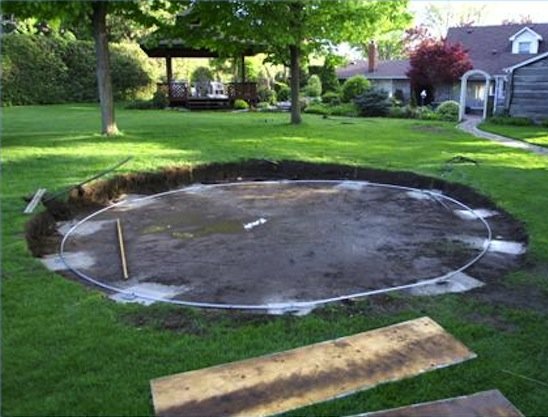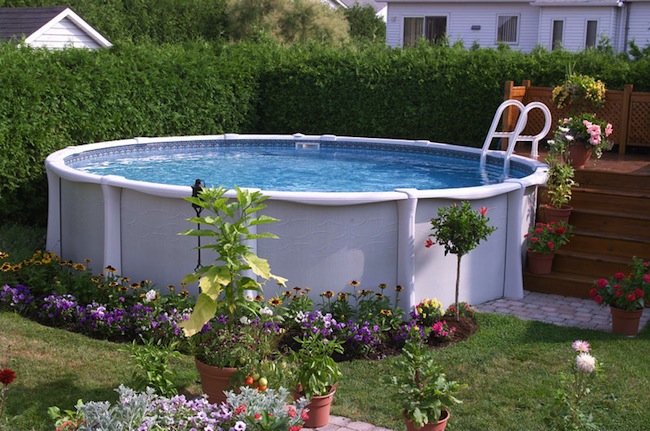We may earn revenue from the products available on this page and participate in affiliate programs. Learn More ›
Nothing epitomizes leisure more than a swimming pool. For some it is a symbol of affluence, but for others a pool is simply a fun way to get exercise, relax, cool off, and gather with friends and family. Whatever your motive, putting in an above-ground pool has the appeal of being less expensive and less permanent than installing one of its in-ground counterparts. That doesn’t mean, however, that an above-ground pool requires any less consideration and planning for its location, size, and operation, or its ongoing care and maintenance. If you’re thinking of putting in an above-ground pool, use this guide to help you plan the essentials.
Siting Your Above-Ground Pool
It is vitally important to choose the right location for your pool.
The first thing you should do is check your local building codes and see if the pool needs to be a certain distance from property lines, septic tanks, and roads. You will also want to avoid underground cables, pipes, and roots, as well as overhead power lines, trees, and eaves.
When choosing a site, consider:
- how much privacy you want
- how easy it will be to supervise children
- how you will secure the pool from wandering toddlers and pets
- how the pool will look in your preferred location
Also consider nearby trees. Trees provide welcome shade, but they may also keep your pool water cooler than desirable throughout the summer. Because trees drop leaves, blossoms, and other organic material, they can also—depending on how far into the fall you use your pool—be a nuisance that dirties the water and affects its chemical balance.
Above-ground pools come in many different sizes, but the size of your pool will be restricted by the size of your site. Once you determine where the pool will go, then you can think specifically about sizes from a simple 12-foot circle on up to a 41′ x 21′ oval.

Prepping the Site
The pool needs to be installed on level ground, so if your site is sloped, you will need to dig out the area to make it level. This may take just a shovel, or you may need to get a Bobcat to adequately prepare the site.
Whatever the case, the pool should be installed on soil that hasn’t been treated with any petroleum-based chemicals, and it shouldn’t be built directly on grass, concrete, asphalt, tar paper, peat moss, gravel, mulch, or wood. If it helps with leveling, you can sink part of the pool 12 to 18 inches into the soil.
Because you are dealing with lots of moisture, it is also a good idea to treat the area where the pool is going with a non-petroleum-based fungicide (view example on Amazon). Spending a little extra time prepping the site could save you some major headaches down the road.

Above-Ground Pool Pumps
To keep the water clean and circulated, you will need a pump and filter for your pool. The size and capacity of these units vary and will need to match the volume of your pool. When in doubt, consider going with a slightly bigger pump than you think you need. It will not only perform better, but also more efficiently.
Above-Ground Pool Filters
There are three different types of filtration systems available:
- sand
- cartridge
- diatomaceous earth (DE)
What’s the best choice? That depends on who you ask and what’s most important to you.

Sand filters are simple and effective, but these also require backwashing and occasional replacement of sand. They are the least efficient of the three.
A high-end cartridge filter is very efficient and easy to maintain, requiring little more than a periodic hosing to keep clean.
Some swear by diatomaceous earth (DE) filters because they produce the cleanest water possible. They can be messy to clean, however, and do require periodic backwashing (running the pump in reverse) to operate efficiently.
Do your research and talk to fellow pool owners in your area to help you in your decision making.

Water Treatment
In addition to cleaning the water with a physical filter, it is necessary to treat the water with either chlorine or salt.
CHLORINE
Chlorine pools are the most common types and require using either disk-like chlorine cakes, or liquid or powdered chlorine to keep the pool clean.
SALT
A salt-filtration system is definitely much better for your skin and hair, because the water is softened and it won’t fade your swimsuit. These systems cost a little more up front but tend to save money down the road because you don’t have to add salt as frequently as you would chlorine.
Though saltwater systems have been gaining popularity, they do have drawbacks.
- Salt is very corrosive, so if your pool has any metal components, you’ll most likely need to replace them after a few years.
- If you go with salt, you will need an all-resin pool, which means that it will be made from a very high-quality plastic that will not corrode.
- It will be necessary to add a salt cell, which creates chlorine from the salt through a process of electrolysis. That’s right: a saltwater pool still uses chlorine to sanitize and disinfect the water. The chlorine is present in much lower concentrations, however, and is not detectable by smell or taste.
All in all, there’s not a huge difference in cost or maintenance, so don’t let these factors alone sway you. There’s lots of debate about the relative merits of salt systems, so do your research and know what you’re getting into before going this route.

Above-Ground Pool Maintenance
Whether you go with a chlorine- or salt-based system, there will be plenty of maintenance to attend to.
- You will need to test and adjust the pH and chlorine (or salt) levels a few times a week, and make sure the water level is at its optimal height. Using test strips or a liquid testing system, you’ll want to ensure that the alkalinity falls between 80 and 150 parts per million (ppm), the pH is between 7.4 and 7.8, and the calcium hardness is between 200 and 400 ppm.
- You will likely need to add an algaecide to get rid of the green stuff that wants to grow.
- For chlorine pools, you’ll also need to check its presence in the water and keep it between 1 and 3 ppm. (If the chlorine falls below this level, you will need to “shock” the pool, which requires adding a high concentration of chlorine in powdered or liquid form and makes the pool inaccessible for swimming for several hours.)
- You will need to remove debris with a skimming net, vacuum the pool, and clean the skimmer and pump baskets regularly. Automatic pool cleaners are available—these patrol the bottom of your pool on their own—but don’t be fooled into thinking that they will eliminate all maintenance.
- Depending on where you live, you may also need to close your pool at the end of the season to extend its life and keep your water as clean as possible.
Now that you know what is involved in planning for your above-ground pool, don’t lose sight of the rewards. Take a moment to envision yourself lounging poolside, sipping on an ice-cold beverage, and taking in the sights and sounds of your friends and family enjoying the summer to its fullest. That will surely make all your efforts worthwhile!

